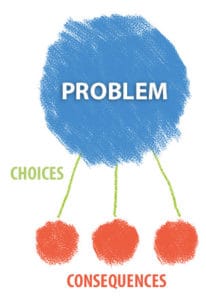
Dinner: Nourish Your Family … As a Family
There’s plenty of evidence that making dinner together a family priority is definitely worth the effort.

Help young child understand how to work through their emotions instead of screaming or throwing tantrums.
Young children often scream when they feel frustrated or the need for your attention. If screaming helps them feel less frustrated or gives them your immediate attention, they will continue this behavior. To stop the pattern, here is what some parents have done:
When our daughter was 3, she would get worked up over having to transition to a different activity.
To help her, we would hold up fingers and tell her to “blow out” the candles. The simple action of
inhaling deeply and then exhaling helped calm her. If she didn’t blow hard, we would wiggle our
fingers and pretend the candles were flickering. Her tears soon turned to laughter, and she’d be
ready to move to the next activity.
—Shari Talbot
My son, Kellen, refused to stay in timeout whenever I tried this form of discipline. Then one day,
after a lot of my son’s screaming as I repeatedly put him in his timeout chair, I chose not to
engage in conversation. I simply moved him back to his spot without giving him any attention.
Suddenly, there was silence. Silence had never happened during my son’s timeouts before. I set the
timer and saw he noticed. He sat quietly until the timer beeped.
Afterward, I knelt next to him and said, “I can’t hear screaming or talking when you’re in timeout,
but I can hear silence. When I hear silence, I will set the timer, and then you can come out of
timeout really fast.” This time, he heard me. It was a lightbulb moment for him — and for me.
—Trisha Bolanos
For a long time my husband and I struggled to manage our son Eli’s temper tantrums. We tried
disciplining, bribing and affirming him. Nothing worked until I asked him, at a time when he was
calm, what he thought he needed when he was angry.
His dark brown eyes looked up at me. “I just need you to hold me,” he said.
That’s it? I was shocked. The next time he started to throw a tantrum, I asked him, “Can I help you
calm down?”
He sat in my lap and sobbed. We didn’t talk. We rocked and cuddled. Then, when he was ready, he ran
off to play. Later, we talked about why he had been so angry.
Eli is now 10, and those days of extreme tantrums are in the past.
—Susan Burkepile
When my oldest son, Grant, was a toddler, he got frustrated easily and threw screaming tantrums. I tried speaking to him, holding him, and even picking him up and taking him to his room. But these tactics only seemed to make him angrier — and made me the audience for his “show.”
One day when he began to scream, I decided to exit the show. Without saying a word, I walked into my bedroom, sat down on my bed and began to read a magazine. Within minutes he came to me, still crying but more in control.
“You left me!” he said, whimpering.
“Screaming hurts Mommy’s ears,” I calmly replied. “I won’t listen to it. If you need help, you must use your words.” The next time Grant saw me exiting the room during a tantrum, he stopped screaming and asked me to stay.
—Katrina Arbuckle
To teach children to keep their voices in check, even when their emotions are running high, you might say:
“I know you don’t want to leave the playground, but Mommy can’t understand you when you’re sobbing. Try using your sad voice and say, ‘Mommy, I’m sad that we are leaving. I know we have to go, but I was having fun.'”
“I understand you’re upset that your friend took the toy you were playing with, but screaming doesn’t help. Can you use your kind voice and say, ‘I was playing with that. May I please have it back?’ and offer a toy to trade?”
“Wow! You made it across the rope ladder. You must be happy. Can you use your happy voice and say, ‘I did it!’?”
—Michelle LaRowe Conover
I don’t always know what causes a tantrum, but I do know that my daughter can’t scream while she’s taking deep breaths. After she is removed from an activity, I remind her to take several deep breaths, and then I join her. We breathe this way together. Only then, when the emotions of the moment have settled a bit, do we talk about the problem.
Before too long, I noticed that when my daughter started to grow frustrated at trying to put on her shoes or in dealing with another child during playtime, she would stop and take a deep breath before continuing. By doing this, she is beginning to learn a simple process for self-regulating her emotions.
—Andrew Newton
When young-child tantrums start to wane by age 4, parents can begin to encourage self-control as a child’s next developmental step. Retooling timeouts is an effective way to teach self-control:
Start. Optimally, you begin this education before the timeout is needed. First, tell your children these timeouts are meant to help them stop and think about their actions so they can make better choices. (When used as a training tool, the timeout is not used as a punishment.)
Choices. During the initial talk, children can choose a timeout location. It should be around the periphery of the general living area. This distinguishes these timeouts from punishment, where the child may be sent to a bedroom, away from the family. A favored blanket or stuffed animal can be placed in the location to help children self-soothe and think things through.
Consequences. The purpose is to help kids understand that for every challenge, there are choices for their behavior. For each choice, there is a consequence. Some consequences are good, and some are unpleasant. To help kids understand this concept, you can draw and talk about the “choices” model (see model below). Have children name the model. You can use this term instead of timeout, if you like.

Timeouts can be used any time children need to correct their behavior or attitude so they can avoid punishment. Should a child refuse this option, then punishment for defiance is warranted.
Timing. When children are sent for these timeouts, they only need to stay as long as it takes to calm down and verbally identify the problem. Once they exercise self-control, kids can be rewarded with a hug or praise.
Review. After a successful timeout, parents and children should review the scenario together to identify behavioral options for the current problem, along with the consequences for each good or poor choice.
Helping kids understand this model of choices and consequences gives them a tool for making better decisions as they grow.
—Mary Martin